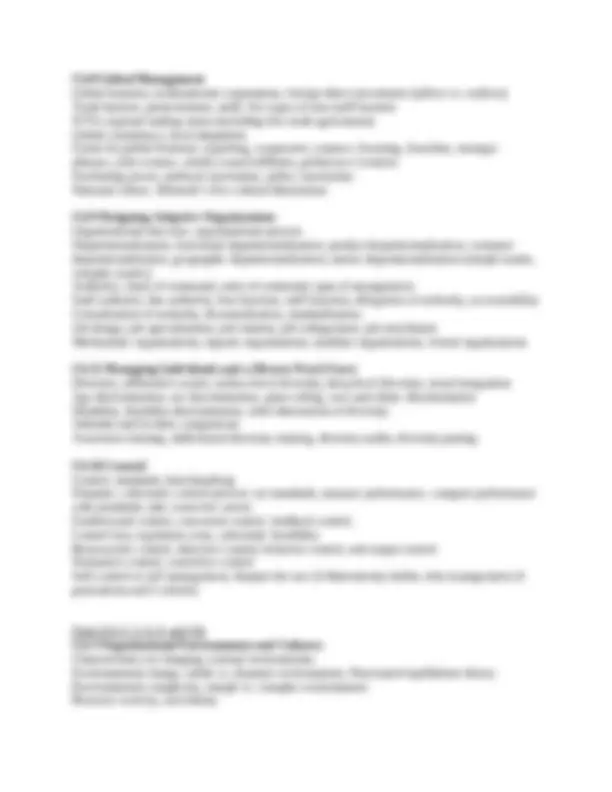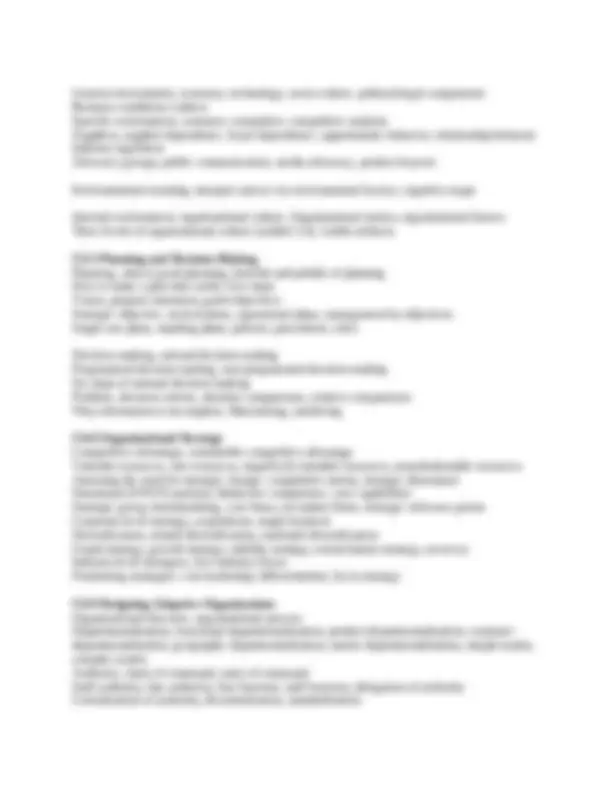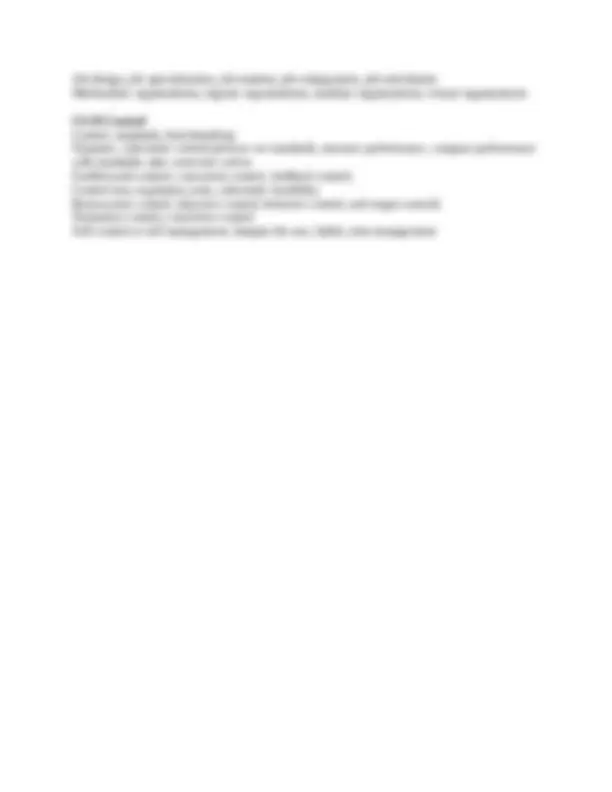





Study with the several resources on Docsity

Earn points by helping other students or get them with a premium plan


Prepare for your exams
Study with the several resources on Docsity

Earn points to download
Earn points by helping other students or get them with a premium plan
Community
Ask the community for help and clear up your study doubts
Discover the best universities in your country according to Docsity users
Free resources
Download our free guides on studying techniques, anxiety management strategies, and thesis advice from Docsity tutors
Midterm & Final Exam Study Guide Material Type: Notes; Professor: Lin; Class: Principles of Management; Subject: Management & Human Resources; University: California State Polytechnic University - Pomona; Term: Fall 2011;
Typology: Study notes
1 / 5

This page cannot be seen from the preview
Don't miss anything!




The study guide is used as a general guide. The exams include everything we covered in class. Textbook: Chuck Williams, MGMT2e, South-Western Cengage Learning, 2010 Midterm #1 (Ch 1, 2, 3, 5, and 6) Ch 1 Management Meaning of management Types of organizational resources Efficiency and effectiveness and their relationships Type of organizations 4 management functions Kinds of managers: top, middle, first-line managers, team leaders General manager, functional managers, project managers Managerial roles: 10 sub-roles under 3 major roles Managerial skills: technical, human, conceptual skills, motivation to manage, core competencies Competitive advantage through people: helps increase sales revenues, profits, stock market returns, and customer satisfaction. Management vs. managers Ch 2 History of Management Scientific management, Frederick W. Taylor, Frank and Lillian Gilbreth Human Relations management, Hawthorne Studies, McGregor: Theory X and Theory Y Systems management Ch 3 Organizational Environments and Cultures Characteristics of changing external environments: Environmental change, stable vs. dynamic environments, Punctuated equilibrium theory Environmental complexity, simple vs. complex environments Resource scarcity, uncertainty General environment, economy, technology, socio-culture, political/legal components Business confidence indices Specific environment, customer, competitor, competitive analysis Suppliers, supplier dependence, buyer dependence, opportunistic behavior, relationship behavior Industry regulation Advocacy groups, public communication, media advocacy, product boycott Environmental scanning, interpret and act on environmental factors, cognitive maps Internal environment, organizational culture, Organizational stories, organizational heroes
Three levels of organizational culture (exhibit 3.4), visible artifacts, visible and invisible levels of corporate culture Ch 5 Planning and Decision Making Planning, what is good planning, benefits and pitfalls of planning How to make a plan that works: five steps Vision, mission, goals/objectives Strategic plan, tactical plans, operational plans, management by objectives Single-use plans, standing plans, policies, procedures, rules Decision making, rational decision making Programmed decision making, non-programmed decision making Six steps of rational decision making Problem, decision criteria, absolute comparisons, relative comparisons Why information is incomplete, Maximizing, satisficing Ch 6 Organizational Strategy Competitive advantage, sustainable competitive advantage Valuable resources, rare resources, imperfectly imitable resources, nonsubstitutable resources Assessing the need for strategic change: competitive inertia, strategic dissonance Situational (SWOT) analysis, distinctive competence, core capabilities Strategic group, benchmarking, core firms, secondary firms, strategic reference points Corporate-level strategy, acquisitions, single business Diversification, related diversification, unrelated diversification Grand strategy, growth strategy, stability strategy, retrenchment strategy, recovery Industry-level strategies, five industry forces Positioning strategies: cost leadership, differentiation, focus strategy Midterm #2 (Ch 4, 8, 9, 12, and 16) Ch 4 Ethics and Social Responsibility Ethics, ethical behavior, sources of code of ethics Workplace deviance: production, property, and political deviances, personal aggression US Sentencing Commission Guidelines for organizations: who, what, why, examples of offenses Ethical dilemma, three domains of human actions Seven ethical principles Overt integrity test, personality-based integrity test Ethics training, rationalizations for unethical behavior, ethical climate, whistle-blowing Social responsibility, shareholder model, stakeholder model, Stakeholders, primary stakeholders, secondary stakeholders Social responsibility, economic, legal, ethical, and discretionary responsibilities Social responsiveness, reactive, defensive, accommodative, and proactive strategies Social responsibility and economic performance
General environment, economy, technology, socio-culture, political/legal components Business confidence indices Specific environment, customer, competitor, competitive analysis Suppliers, supplier dependence, buyer dependence, opportunistic behavior, relationship behavior Industry regulation Advocacy groups, public communication, media advocacy, product boycott Environmental scanning, interpret and act on environmental factors, cognitive maps Internal environment, organizational culture, Organizational stories, organizational heroes Three levels of organizational culture (exhibit 3.4), visible artifacts Ch 5 Planning and Decision Making Planning, what is good planning, benefits and pitfalls of planning How to make a plan that works: five steps Vision, purpose statement, goals/objectives Strategic objective, tactical plans, operational plans, management by objectives Single-use plans, standing plans, policies, procedures, rules Decision making, rational decision making Programmed decision making, non-programmed decision making Six steps of rational decision making Problem, decision criteria, absolute comparisons, relative comparisons Why information is incomplete, Maximizing, satisficing Ch 6 Organizational Strategy Competitive advantage, sustainable competitive advantage Valuable resources, rare resources, imperfectly imitable resources, nonsubstitutable resources Assessing the need for strategic change: competitive inertia, strategic dissonance Situational (SWOT) analysis, distinctive competence, core capabilities Strategic group, benchmarking, core firms, secondary firms, strategic reference points Corporate-level strategy, acquisitions, single business Diversification, related diversification, unrelated diversification Grand strategy, growth strategy, stability strategy, retrenchment strategy, recovery Industry-level strategies, five industry forces Positioning strategies: cost leadership, differentiation, focus strategy Ch 9 Designing Adaptive Organizations Organizational structure, organizational process Departmentalization, functional departmentalization, product departmentalization, customer departmentalization, geographic departmentalization, matrix departmentalization, simple matrix, complex matrix Authority, chain of command, unity of command Staff authority, line authority, line function, staff function, delegation of authority Centralization of authority, decentralization, standardization
Job design, job specialization, job rotation, job enlargement, job enrichment Mechanistic organizations, organic organizations, modular organizations, virtual organizations Ch 16 Control Control, standards, benchmarking Dynamic, cybernetic control process: set standards, measure performance, compare performance with standards, take corrective action Feedforward control, concurrent control, feedback control, Control loss, regulation costs, cybernetic feasibility Bureaucratic control, objective control, behavior control, and output control) Normative control, concertive control Self-control or self management, sharpen the saw, habits, time management